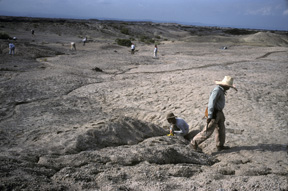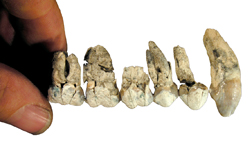Geotimes

Untitled Document

News Notes
Human Evolution
Found: One of many missing human links
 Researchers
working in Ethiopia recently uncovered bones and teeth from one of many previously
missing links in the hominid family tree. The newly found remains, researchers
say, connect two well-known hominid species that are separated by 1 million
years.
Researchers
working in Ethiopia recently uncovered bones and teeth from one of many previously
missing links in the hominid family tree. The newly found remains, researchers
say, connect two well-known hominid species that are separated by 1 million
years.
Researchers in the Middle Awash region
of Ethiopia painstakingly recover bones and teeth of ancient hominids. Copyright
2002 David L. Brill\Brill Atlanta.
Generally speaking, three different phases of human evolution have occurred
over the past 6 million years, says Tim White, a paleoanthropologist at the
University of California in Berkeley, and a team leader
on the new discovery. The past 2 million years “are us and our ancestors,
Homo,” he says — marked by a wide geographic range, wide variety
in dietary habits, big brains, small teeth and tool usage.
Roughly 2 million years prior, fairly geographically and ecologically widespread,
small-brained hominids from the genus Australopithecus walked upright
and had relatively larger cheek teeth, White says. And roughly 4 million years
ago and earlier, hominids from the group Ardipithecus walked upright,
likely had smaller brains and larger teeth, and filled smaller dietary niches
and geographic ranges.
Homo is generally thought to have descended in part from Australopithecus,
which in turn, is thought to have evolved from Ardipithecus, White says.
One problem in truly understanding these evolutionary relationships has long
been the missing links between them, however. Nearly 1 million years separate
the well-known species Australopithecus afarensis, including the famed
Lucy (see Geotimes, May 2001) from the older Ardipithecus
ramidus, and the morphological features of the specimens, while similar,
did not necessarily support a direct lineage, as White and colleagues reported
in the April 13 Nature.
 A few years
ago, researchers found a possible intermediary species, Australopithecus
anamensis, in Kenya, about 1,000 kilometers away from the current dig site.
Because it was not in the same region as the other two species, however, it
did not help directly support the lineage.
A few years
ago, researchers found a possible intermediary species, Australopithecus
anamensis, in Kenya, about 1,000 kilometers away from the current dig site.
Because it was not in the same region as the other two species, however, it
did not help directly support the lineage.
The teeth are from an intermediary species
of hominid that links two previously known species in the human family tree.
Copyright 2005 Tim D. White\Brill Atlanta.
The newly dated Au. anamensis specimens are about 4.1 million years
old and in the same geographical location in successive geologic layers as the
other species, thus effectively bridging the gap between Homo ancestor
groups, White says. Au. anamensis is the most primitive Australopithecine
found to date.
White’s team recovered about 30 teeth and finger, toe and leg bones from
eight individuals in a layer of rock in the Afar desert in Ethiopia that they
dated to about 4.1 to 4.2 million years ago. The bones and teeth share features
of both the older Ar. ramidus and the more recent Au. afarensis
and are an intermediary between the two species, both morphologically and temporally.
“We now know where Lucy and her kind [Au. afarensis] came from,”
White says, but the research raises further questions as well.
It remains unclear whether or not Ar. ramidus could have been an ancestor
to Au. anamensis, as the two species are only separated by 300,000 years
or so, a relatively small amount of geological time, White says. “We put
forth two hypotheses about the origin of Au. anamensis,” he says:
One supports a conventional straight-line evolution from parent to daughter
species, and the other is that it was punctuated equilibrium, where there was
a quick split from parent to daughter.
“For the moment, it’s really not possible to choose” one hypothesis
over the other, says Michel Brunet, a paleoanthropologist at the University
of Poitiers in France. Neither hypothesis can be discarded or proven without
more fossil evidence to fill in the remaining gaps.
Nevertheless, Brunet says, “this is a very important find and contribution
to our knowledge of the human story.”
Megan Sever
Links:
Human
Evolution Research Center at Berkeley
"From tree to tumbleweed,"
Geotimes, May 2001
"New evidence for earliest hominid,"
Geotimes online, Web Extra, April 15, 2005
"Redating the earliest humans,"
Geotimes online, Web Extra, Feb. 28, 2005
Back to top
Untitled Document

 Researchers
working in Ethiopia recently uncovered bones and teeth from one of many previously
missing links in the hominid family tree. The newly found remains, researchers
say, connect two well-known hominid species that are separated by 1 million
years.
Researchers
working in Ethiopia recently uncovered bones and teeth from one of many previously
missing links in the hominid family tree. The newly found remains, researchers
say, connect two well-known hominid species that are separated by 1 million
years.

 A few years
ago, researchers found a possible intermediary species, Australopithecus
anamensis, in Kenya, about 1,000 kilometers away from the current dig site.
Because it was not in the same region as the other two species, however, it
did not help directly support the lineage.
A few years
ago, researchers found a possible intermediary species, Australopithecus
anamensis, in Kenya, about 1,000 kilometers away from the current dig site.
Because it was not in the same region as the other two species, however, it
did not help directly support the lineage.
